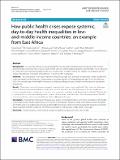| dc.contributor.author | Davis, Alicia | |
| dc.contributor.author | Lembo, Tiziana | |
| dc.contributor.author | Laurie, Emma | |
| dc.contributor.author | Mutua, Edna | |
| dc.contributor.author | Loosli, Kathrin | |
| dc.contributor.author | Nthambi, Mary | |
| dc.contributor.author | Nimegeer, Amy | |
| dc.contributor.author | Mnzava, Kunda | |
| dc.contributor.author | Msoka, Elizabeth | |
| dc.contributor.author | Nasuwa, Fortunata | |
| dc.contributor.author | Melubo, Matayo | |
| dc.contributor.author | Shirima, Gabriel | |
| dc.contributor.author | Matthews, Louise | |
| dc.contributor.author | Hilton, Shona | |
| dc.contributor.author | Mshana, Stephen | |
| dc.contributor.author | Mmbaga, Blandina | |
| dc.date.accessioned | 2023-09-21T08:39:02Z | |
| dc.date.available | 2023-09-21T08:39:02Z | |
| dc.date.issued | 2022-02-14 | |
| dc.identifier.uri | https://doi.org/10.1186/s13756-022-01071-5 | |
| dc.identifier.uri | https://dspace.nm-aist.ac.tz/handle/20.500.12479/2039 | |
| dc.description | This research article was published in the Antimicrobial Resistance & Infection Control 11, Article number: 34, 2022 | en_US |
| dc.description.abstract | Background: The current Coronavirus disease pandemic reveals political and structural inequities of the world’s
poorest people who have little or no access to health care and yet the largest burdens of poor health. This is in parallel
to a more persistent but silent global health crisis, antimicrobial resistance (AMR). We explore the fundamental chal-
lenges of health care in humans and animals in relation to AMR in Tanzania.
Methods: We conducted 57 individual interviews and focus groups with providers and patients in high, middle and
lower tier health care facilities and communities across three regions of Tanzania between April 2019 and February
2020. We covered topics from health infrastructure and prescribing practices to health communication and patient
experiences.
Results: Three interconnected themes emerged about systemic issues impacting health. First, there are challenges
around infrastructure and availability of vital resources such as healthcare staff and supplies. Second, health out-
comes are predicated on patient and provider access to services as well as social determinants of health. Third, health
communication is critical in defining trusted sources of information, and narratives of blame emerge around health
outcomes with the onus of responsibility for action falling on individuals.
Conclusion: Entanglements between infrastructure, access and communication exist while constraints in the health
system lead to poor health outcomes even in ‘normal’ circumstances. These are likely to be relevant across the globe
and highly topical for addressing pressing global health challenges. Redressing structural health inequities can better
equip countries and their citizens to not only face pandemics but also day-to-day health challenges. | en_US |
| dc.language.iso | en | en_US |
| dc.publisher | Springer Nature | en_US |
| dc.subject | Health inequities | en_US |
| dc.subject | Antimicrobial resistance | en_US |
| dc.subject | Qualitative data | en_US |
| dc.subject | One Health | en_US |
| dc.title | How public health crises expose systemic, day-to-day health inequalities in low- and-middle income countries: an example from East Africa | en_US |
| dc.type | Article | en_US |

